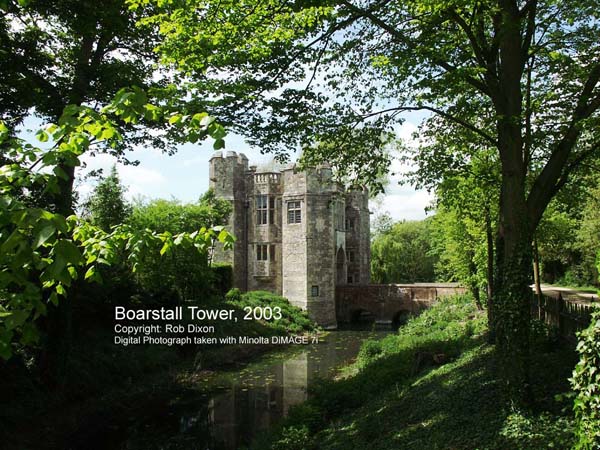On 12th September 1312, King Edward II granted John de Haudlo a license to fortify his mansion house at Boarstall with a wall of lime and stone.
The magnificent fortified gatehouse seen in the photograph above and known for some time as Boarstall Tower is the result. This may seem a somewhat free
interpretation of the license quod ipse mansum suum de Borstall [sic] juxta Brehull [Brill] in Com. Buck. muro de petra & calce firmare &
kernellare possit but all licenses "to crenellate" were similarly worded.
Some of the beams to be seen today downstairs in the Tower have been dated using dendochronology and this tells us that they were cut from oaks that were felled in
1312. Since they could only work green oak at that time, we can be sure that, as soon as the trees were felled, they were split and the beams put in place so that
construction of the Tower must have actually started in 1312.
We do not know whether de Haudlo's parents-in-law, the Fitz-Nigel's, built the original house or de Haudlo built it himself, but the Fitz-Nigel's had
lived at Boarstall for some time. Thus we cannot be sure how old the existing house was in 1312 nor what it looked like. We can speculate whether the house in 1312 was
same size as that shown in a 1695 line engraving of Boarstall by Michael Burghers or whether, as seems more likely, it
was somewhat
smaller part of that.
What is certain is
that the tower is out of all proportion to the size of both what may have been the original house and even to the larger 1695 house.
The obvious questions that arise are "Why did John de Haudlo feel the need to build what was, for its time, a very large and grand gatehouse? Who was the enemy
against
whom he felt the need to defend himself?"
Almost certainly, the answer is that there was no real enemy. Although constructed as a defensive building, in line with the license to crenellate, this surely was
its
secondary purpose. Primarily the fortified gatehouse was a status symbol, very grand for its time and, even though it was not a true castle, its construction followed
the latest fashions in castle building.
The moat, which now surrounds the three acre moat platform on three sides only, and was presumably on four sides originally, may be 13th century and, if so, predating
the tower and confirming that there was a house there in the late 13th century.
Copyright Rob Dixon, 2003
Contact Information

See also
Further Images of The Tower
Boarstall as it was
Boarstall
Tower in 2003 (the exterior little altered from 1615)
(Copyright Rob Dixon - Digital photograph taken with Minolta Dimage 7i)
The Tenant, Boarstall Tower, Boarstall, Aylesbury HP18 9UX
Tel: 44 (0) 1844 239 339